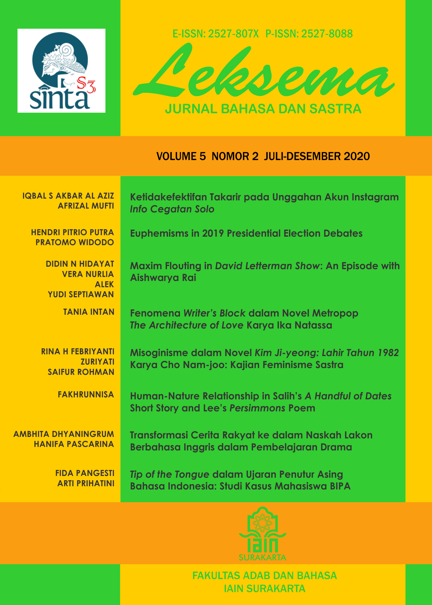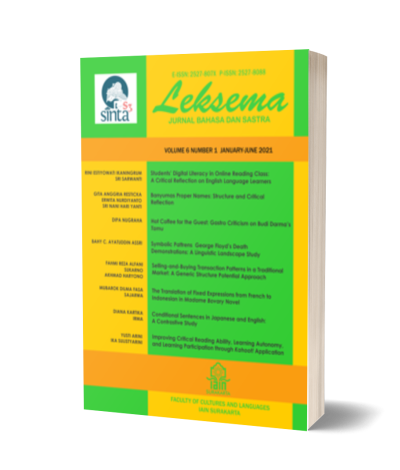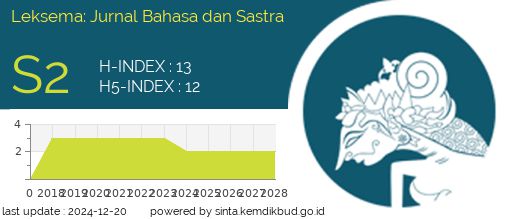'TIP OF THE TONGUE' IN THE UTTERANCES OF INDONESIAN FOREIGN SPEAKERS: CASE STUDY OF BIPA STUDENTS ('TIP OF THE TONGUE' DALAM UJARAN PENUTUR ASING BAHASA INDONESIA: STUDI KASUS MAHASISWA BIPA)
DOI:
https://doi.org/10.22515/ljbs.v5i2.2200Keywords:
tip of the tongue, foreign speaker, bahasa IndonesiaAbstract
Tip of the tongue (ToT) is experienced by BIPA students when speaking Indonesian due to delayed lexical access. This study aims to describe two focuses, namely: (1) the characteristics of the target vocabulary and the ToT vocabulary and (2) the mental processes when the ToT occurs. The theory used in this research is lexical retrieval in morphosemantics. This research method is descriptive qualitative. Data collection was carried out by observation and interview techniques during the learning process of BIPA Muhammadiyah Malang University. The results showed that ToT occurred in nouns (42%), verbs (24%), adjectives (21%), conjunctions (8%), and numeralia (5%). Tip of the tongue is accompanied by a lot of silence as a fallacy effect that appears in the speech. Gestur becomes a description of the meaning features of the target vocabulary. The mental process of ToT occurs in several events, namely (1) the speaker has a picture of the object in his mind, (2) the activation of the semantic set when the active vocabulary has a relation with the meaning of the target vocabulary, (3) activation of the meaning field when the speaker describes it, (4) activation of the phonological set when the similar sound vocabulary appears in the mind, and (5) the appearance of the first language and / or intermediate language.
Downloads
References
Afrilia, L. K. 2015. Tip of the Tongue pada penutur Indonesia: Implikasi terhadap Model Akses Leksikal. Jurnal Universitas Indonesia.
Calabi, Clotilde. 2016. “Ancona?†Aha! That’s Her Name! Tip-of-The-Tongue Experiences. Analysis, 76(4): 409-418. https://academic.oup.com/analysis/article-abstract/76/4/409/ 2624116
Ecke, Peter. 2004. Words on The Tip of The Tongue: A Study of Lexical Retrieval Failures in Spanish-English Bilinguals. Southwet Journal of Linguiatics Vol. 23(2): 33-63.
Ecke, Peter. 2009. The Tip-of-The-Tongue Phenomenon as A Window on (Bilingual) Lexical Retrieval. Anita
Pavlenko (Ed.) The Bilingual Mental Lexicon: Interdisciplinary Approaches. Hal. 185-208. Bristol: Multilingual Matters.
Ecke, P., & Hall, C. J. 2013. Tracking Tip-of-The-Tongue States in A Multilingual Speaker: Evidence of Attrition or Instability in Lexical Systems? International Journal of Bilingualism, 17(6): 734-751. https://journals.sagepub.com/doi/abs/10. 1177/136700691245 4623
Fernandez, Eva M. dan Cairns, Helen Smith. 2011. Fundamentals of Psycholinguistics. West Sussex: Wiley-Blackwell.
Gianico-Relyea, J. L., & Altarriba, J. 2012. Word Concreteness as A Moderator of The Tip-of-The-Tongue Effect. The Psychological Record, 62(4): 763-776. https://link.springer.com/article/10.1007/BF03395834
Gollan, T. H., & Silverberg, N. B. 2001. Tip-of-The-Tongue States in Hebrew–English Bilinguals. Bilingualism: Language and Cognition, 4, 63–83.
Hodairiyah, H., & Utama, F. F. 2019. Bentuk-bentuk Kalimat Imperatif Permintaan pada Iklan Rokok 'Djarum 76'. Leksema: Jurnal Bahasa dan Sastra, 4(1), 11-20.
Kozlovskiy, S.A., Shirenova, S. D. dan Neklyudova, A. K. 2017. Brain Mechanisms of The Tip-of-The-Tongue State: An Electroencephalography-Based Source Localization Study. Psychology in Russia, 10(3): 218-230. https://cyberleninka.ru/article/n/brain-mechanisms-of-the-tip-of-the-tongue-state-an-electroencephalography-based-source-localization-study
Pangesti, Fida. 2014. Fenomena Senyapan: Studi Kontrastif terhadap Tuturan Terencana dan Tuturan Spontan. In: International Seminar “Language Maintenance and Shift†IV ISSN; 2088-6799, 18 November 2014, Hotel NEO Semarang.
Pinet, S., & Nozari, N. 2018. “Twisting fingersâ€: The Case for Interactivity in Typed Language Production. Psychonomic Bulletin & Review, 25(4): 1449-1457. https://link.springer.com/article/10.3758/s13423-018-1452-7
Prihatini, Arti. 2019. Semantic Network of The Word Association in The Field of Law. Litera, 18 (3): 430-446.
Radel, Remi dan Fournier, Marion. 2017. The Influence of External Stimulation in Missing Knowledge Retrieval. Memory Vol. 25(9): 1217-1224. https://www.tandfonline.com/ doi/ abs/10.1080/09658211.2017.1282519
Rahman, Azkia Rostiani, Kushartanti, dan Anjarningsih, Harwinta Juhria. 2017. Tip of The Tongue Analysis in Indonesian Language Speaker: A Case Study. People: International Journal of Social Science: Vol 3 (3): 292—300. (Online), http://creativecommons.org/ licenses/by-nc/4.0/
Schwartz, B. L. 2008. Working Memory Load Differentially Affects Tip-of-The-Tongue States and Feeling-of-Knowing Judgments. Memory & Cognition, 36(1): 9-19. https://link.springer.com/article/10.3758/MC.36.1.9
Schwartz, B. L. 2010. The Effects of Emotion on Tip-of-The-Tongue States. Psychonomic Bulletin & Review, 17(1), 82-87. https://link.springer.com/article/10.3758/PBR. 17.1.82
Singleton, David. 2000. Language and The Lexicon: An Introduction. London: Arnold.
Downloads
Published
Issue
Section
License
The copyright of the received article shall be assigned to the publisher of the journal. The intended copyright includes the right to publish the article in various forms (including reprints). The journal maintains the publishing rights to published articles.
In line with the license, the authors and users (readers or other researchers) are allowed to share and adapt the material only for non-commercial purposes. In addition, the material must be given appropriate credit, provided with a link to the license, and indicated if changes were made. If authors remix, transform or build upon the material, authors must distribute their contributions under the same license as the original.







